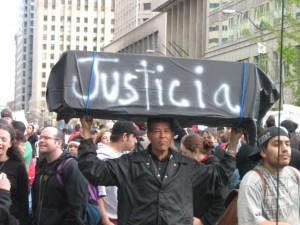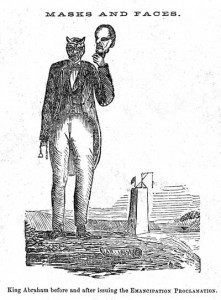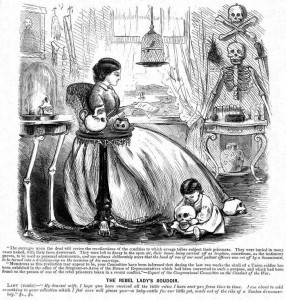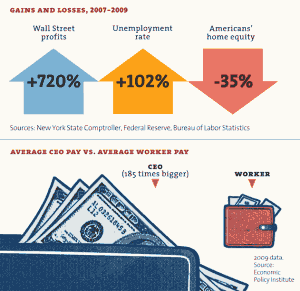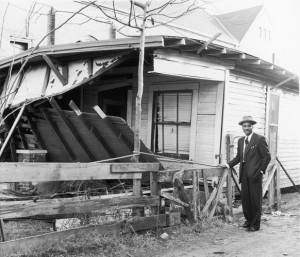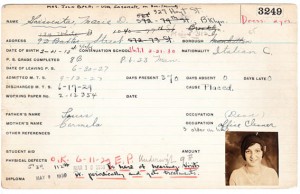 We’re happy to share that American Social History Project/Center for Media and Learning is a Stage 1 winner in the MacArthur Foundation’s Digital Media and Learning Teacher Mastery badge competition (whew, that was a mouthful). Our proposal seeks to develop a badge system for an online professional development community where teachers can develop their skills as history educators, instructional designers, and peer collaborators. Now it’s on to Stage 2, where we’re working with game developers and education researchers to submit a proposal that describes in greater detail how teachers can earn badges, what the badges will look like, and how the system will work technically. And, if all goes very well, we’ll be heading to San Francisco at the end of February to pitch the project in front of a live panel of judges. Whatever happens, we are learning the ins and outs of badging as a way to motivate and recognize lifelong professional learning.
We’re happy to share that American Social History Project/Center for Media and Learning is a Stage 1 winner in the MacArthur Foundation’s Digital Media and Learning Teacher Mastery badge competition (whew, that was a mouthful). Our proposal seeks to develop a badge system for an online professional development community where teachers can develop their skills as history educators, instructional designers, and peer collaborators. Now it’s on to Stage 2, where we’re working with game developers and education researchers to submit a proposal that describes in greater detail how teachers can earn badges, what the badges will look like, and how the system will work technically. And, if all goes very well, we’ll be heading to San Francisco at the end of February to pitch the project in front of a live panel of judges. Whatever happens, we are learning the ins and outs of badging as a way to motivate and recognize lifelong professional learning.
In Support of Mexican American Studies
Arizona’s HB 2281 goes into effect today, and Historians Against the War is calling for instructors around the country to take a few minutes in classes or other places to read a passage from one of the books that the law requires be removed from classrooms throughout the state. The books are:
Critical Race Theory by Richard Delgado
500 Years of Chicano History in Pictures edited by Elizabeth Martinez
Message to Aztlan by Rodolfo Corky Gonzales
Chicano! The History of the Mexican Civil Rights Movement by Arturo Rosales
Pedagogy of the Oppressed by Paulo Fiere
Rethinking Columbus: The Next 500 Years edited by Bill Bigelow and Bob Peterson
Occupied America: A History of Chicanos by Rodolfo Acuña
Here’s a passage from Occupied America: A History of Chicanos about the Oxnard, California strike of 1903, where Mexican and Japanese immigrant agricultural workers joined forces against the unfair labor practices of local growers. You can also find documents relating to this strike in HERB, with more on the way.
In 1903, Japanese and Mexican workers in Oxnard, California, protested the practices of the Western Agricultural Contracting Company. The Company withheld a percentage of the workers’ salaries until the end of the contract. Workers were charged for unnecessary services. They were paid in scrip and thus were forced to buy at the company store at inflated prices. The beet workers formed the Japanese-Mexican Labor Association and after a series of meetings struck on February 28. From the beginning ‘the growers, the major contractors, major businessmen, the judges, juries, sheriffs, and officials,’ all of whom were Anglo, united to oppose workers. On March 23 an armed conflict broke out and Luis Vasquez died of shotgun wounds.
Workers won a limited victory with the concession that union members be employed on the majority of the contracting companies’ farms. After the strike they formed the Sugar Beet and Farm Laborers Union of Oxnard and petition the American Federation of Labor for affiliation. Samuel Gompers, president of the AFL, turned down the request unless the membership guaranteed that Chines and Japanese would not be admitted, but the Mexican workers refused to abandon their Japanese comrades.
—Rodolfo Acuña, Occupied America: A History of Chicanos, 155.
ASHP/CML Hosts an NEH Summer Institute on the Visual Culture of the Civil War
The American Social History Project/Center for Media and Learning is now accepting applications for a two-week NEH Summer Institute for college and university teachers on the visual culture of the American Civil War.
The Institute will focus on the era’s array of visual media−including the fine arts, ephemera, and photography−to examine how information and opinion about the war were recorded and disseminated, and the ways visual media expressed and shaped Americans’ understanding on both sides of the conflict. Guided by a team of four faculty that represents the range of work in the field, Institute participants will hear daily lectures and presentations by noted historians, art historians, and archivists; take part in hands-on sessions in significant museums and collections; and attend new media lab workshops. These Institute activities will introduce participants to the rich body of scholarship that addresses or incorporates Civil War era visual culture, encourage them to explore avenues for further research in the field, and assist them in developing their own research and/or teaching projects. Reading assignments preceding and during the Institute will prepare participants for full engagement in the Institute’s discussions and activities. And ample time will be provided to prepare individual projects, undertake research at local archives, and meet with the four principal institute faculty members.
The institute will meet from July 9 to July 20, 2012 at the CUNY Graduate Center (34th Street and Fifth Avenue) and other archival and museum sites around the city, including the New-York Historical Society and the Newark Museum. Faculty and visiting speakers include: Jeanie Attie, Georgia Barnhill, Joshua Brown, Sarah Burns, Gregory Downs, Alice Fahs, Harold Holzer, David Jaffee, Anthony Lee, Bruce Levine, Louis P. Masur, Cynthia Mills, Michael Sappol, Richard Samuel West, Deborah Willis, and Peter H. Wood.
Independent scholars, scholars engaged in museum work or full-time graduate studies are urged to apply. While scholars and teachers specializing in U.S. history, American Studies, and art history might find the Institute especially attractive, we encourage applicants from any field who are interested in the Civil War and its visual culture, regardless of your disciplinary interests. You need not have extensive prior knowledge of the Civil War or visual culture or have previously incorporated their study in any of your courses or research. However, your application essay should identify concrete ways in which two weeks of concentration on the topics will enhance your teaching and/or research. In addition, please describe a research or teaching project you will develop during the institute. The ideal institute participant will bring to the group a fresh understanding of the relevance of the topic to their teaching and research.
Full details and application information are available on the ASHP/CML NEH Institute website. For further information, please contact Institute Director Donna Thompson Ray. Completed applications must be submitted via our online application system or e-mail or postal mail no later than March 1, 2012 (postal mail must be postmarked by March 1).
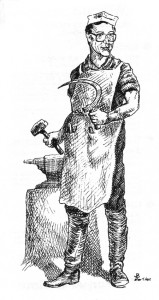 We mark the passing of David Montgomery today at the age of 84. David was one of the most influential historians of the U.S. working class, a long time trade union activist, and a mentor and inspiration to generations of scholars and students. His scholarship shaped the American Social History Project’s work as did his example as a an educator who never sought solace, refuge, or the privilege of the ivory tower.
We mark the passing of David Montgomery today at the age of 84. David was one of the most influential historians of the U.S. working class, a long time trade union activist, and a mentor and inspiration to generations of scholars and students. His scholarship shaped the American Social History Project’s work as did his example as a an educator who never sought solace, refuge, or the privilege of the ivory tower.
Jon Wiener’s remembrance on The Nation blog succinctly captures the man.
As creators of textbooks and other materials for teaching history, we here at ASHP are suckers for good data visualization. Here are some of our favorite examples, the ones that get us thinking about how digital media can make historical data a whole lot more meaningful to students.
The New York Times leads the way on creating effective data visualizations to accompany and enhance its news and analysis. Their Immigration Explorer tracks the geographic settlement across the U.S. of various immigrant groups since 1880 and allows users both to isolate the view to individual ethnic groups or view all at once, along with county-level population data.
And their A Historic Shift, published the morning after the 2010 midterm elections, used inventive moving graphics to illustrate a series of the 10 most notable facts and implications of the election results.
Cartographer Derek Watkins provides an animated graphic of the expansion of post offices across the territorial U.S. from 1700-1900 that could easily use many other kinds of data to demonstrate the growth or decline over time and space of any number of groups, industries, or phenomena.
These colorful charts from Mother Jones may be static, but they quite effectively document the growing income inequality that is motivating the Occupy Wall Street protestors. Certainly textbooks could benefit from an infusion of the magazine world’s infographic style.
Link Friday: Digital History, Fred Shuttlesworth
Writing History in a Digital Age is an attempt to create an entirely “born digital” collection of historical writing, using open source methods and tools to create a volume of essays about how digital media is changing the way historians do what they do. Conceived and edited by Jack Dougherty and Kristen Nawrotzki, it’s an admirable attempt to push the historical profession forward into a new age of writing, evaluating, and publishing scholarly work. (And in that respect it reminds me of Roy Rosenzweig’s long ago experimental “hypertext issue” of the American Quarterly.) It’s open now through November 14th for peer review from any and all comers, so stop by to read and comment on some of the essays (maybe even the one penned by yours truly, “Building a Better Textbook”).
Rev. Fred L. Shuttlesworth, a giant of the civil rights movement, died on Wednesday. He was a key figure in the Birmingham, Alabama public protest campaign and the Southern Christian Leadership Conference, and he describes those years in absolutely riveting interviews in the Eyes on the Prize documentary. To see what he and so many others were fighting against, check out these examples of the city’s segregation ordinances on HERB.
Finally, on a lighter note, all the best protest movements have a sense of humor about themselves. These examples of the Occupy Sesame Street meme on twitter and the web will make you smile.
Link Monday: Remembering Adina Back, Class Warfare
The Jewish Women’s Archive has posted a beautiful remembrance and celebration of the public history career of our late colleague and friend Adina Back.
With class warfare in the news, why not check out our documentary DVD and Viewer’s Guide 1877: The Grand Army of Starvation. *That* was class warfare.
For links all week long, you can follow us on Twitter @ashp_cml and at www.facebook.com/ashpcml
Link Friday: 1920s Report Cards and CUNY’s Mission
Slate‘s recent five-part Permanent Record series begins with the tale of how its author Paul Lukas and a few friends stumbled upon a file cabinet in the basement of Stuyvesant High School marked “Throw Out” that was filled with 1920s era report cards from the Manhattan Trade School for Girls. Lukas and his friends grabbed as many as they could, and the series chronicles both his attempts to track down the descendants of the young women immortalized on the cards and what they tell us about women, work, and education in 1920s and 1930s New York City. While I sigh a little for the dissertation that was surely lost when the complete set of report cards was consigned to the landfill, the series—buoyed by Lukas’s loving obsession with these artifacts—is a delightful read.
Don’t miss “I develop free software because of CUNY and Blackboard” by CUNY’s own Boone Gorges, an eloquent and incisive blog post about why he has committed a great deal of uncompensated time to programming open source courseware alternatives to Blackboard. It’s a worthy reminder that we should resist business-as-usual when it undermines CUNY’s public mission.
Like Dick Cheney, Link Friday has been out of the public eye for many months. But it’s back now! Hawking not a memoir but some history resources you shouldn’t miss:
The Virginia Historical Society’s Unknown No Longer is a database of slave names gathered from the many records in their collections. Users see not just the names but the full documents in which they appear, such as probate inventories and bills of sale. The documents are searchable by name and occupation and the site also has a great map interface, so you can go directly to the documents from a particular Virginia city or town. It will be a boon to genealogists and other historical researchers and VHS promises that it will continue to grow.
In case you missed it, Steve Fraser and Josh Freeman’s “The Secret History of America’s Unemployed” in Salon is a terrific account of the history of unemployment in the U.S.: as an artifact of industrial capitalism, a lived reality for workers, and an impetus for collective mobilization.
Claire Potter had a thoughtful blog post on teaching the September 11th attacks using materials in the 9.11 Digital Archive, created by ASHP and the Center for History and New Media.
And Jeremiah McCall reviewed the first installment of our Mission U.S. game at the National History Education Clearinghouse site.

The Robert Gould Shaw memorial in Boston, which commemorates the 54th Massachusetts Colored Regiment of the Union army
At yesterday’s September 11th memorial ceremony in New York City, former President George W. Bush read a condolence letter written by President Abraham Lincoln in 1864 to Mrs. Lydia Bixby, who was “the mother of five sons who have died gloriously on the field of battle.” It is an eloquent, affecting letter that evokes an unimaginable kind of sorrow. Published in a newspaper on the same day that it was hand delivered to Mrs. Bixby, it was clearly intended both as a private gesture and a message designed to help a war-weary public keep the faith. Fitting, then, on both counts for use at the September 11th memorial.
But decidedly not fitting is the letter’s final line, where Lincoln consoles the grieving mother by reminding her of “the solemn pride that must be yours to have laid so costly a sacrifice upon the altar of freedom.” The deeply mourned victims of September 11th were people who went to work, or got on an airplane, and experienced horrifying ends. They were heroic in their support for each other and willingness to put their own lives in jeopardy for the sake of others–an example of communal care that should be commemorated in its own right. But they were not freedom fighters in the way that the young men who enlisted in the Union army were. There is a politics to the slippage that allows us to bundle all tragic sacrifice together into a narrative of national greatness. Equating the September 11th victims with Civil War casualties reinforces the political framework of the “War on Terror” that politicians and the media launched after the 9.11 attacks. It also obscures the nature of the Civil War at a time when many Americans still believe it was fought over “states rights” and not over slavery. By 1864, the Union was engaged in a genuine freedom fight, seeking to emancipate millions of enslaved people. By all means, let’s commemorate examples of heroism in U.S. history, but let’s be true to the spirit and the facts of the past.

